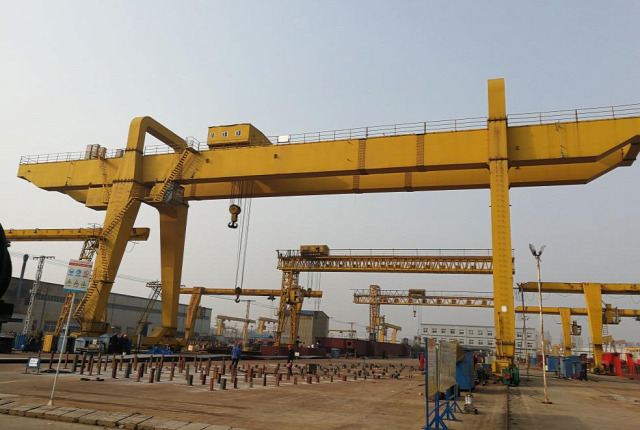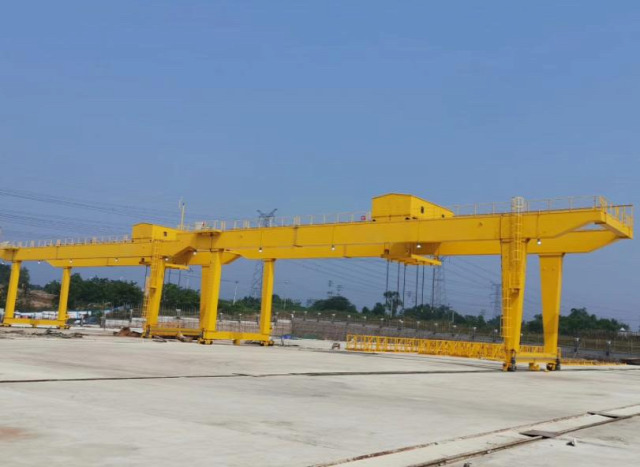Gantry cranes are integral equipment used across a range of industries, including construction, shipping, steel production, and manufacturing. These cranes are designed to lift and move heavy loads, and their versatility makes them essential in both indoor and outdoor settings. Gantry cranes come in two primary types: electric and hydraulic. Both offer distinct advantages and disadvantages, particularly in terms of cost. For businesses considering an investment in gantry cranes, it’s crucial to understand the cost differences between electric and hydraulic models, as these can significantly impact both initial investment and long-term operating costs. This article will provide a detailed cost comparison between electric and hydraulic gantry cranes, including both the upfront investment and the ongoing costs associated with each.

Understanding Electric and Hydraulic Gantry Cranes
Before diving into the gantry crane cost comparison, it’s essential to understand the fundamental differences between electric and hydraulic gantry cranes:
-
Electric Gantry Cranes: These cranes are powered by electric motors, which drive the movement of the crane's hoisting system, trolleys, and the gantry’s wheels. Electric cranes are often more efficient in terms of energy consumption and offer smooth, precise control. They are commonly used in environments where a consistent and continuous power source is available.
-
Hydraulic Gantry Cranes: These cranes rely on hydraulic systems, where hydraulic pumps and cylinders are used to lift and move heavy loads. The hydraulic system provides powerful lifting capabilities, especially for extremely heavy loads, and offers greater flexibility in terms of lifting height adjustments and positioning. Hydraulic cranes are often used in outdoor or construction environments, where portability and the ability to work in rough conditions are critical.
Initial Purchase Cost: Electric vs. Hydraulic
The initial purchase cost of a gantry crane is one of the most significant financial considerations. The price of both electric and hydraulic gantry cranes can vary depending on several factors, including lifting capacity, span, height, and customization. However, in general, there are some noticeable differences in cost between electric and hydraulic models.
-
Electric Gantry Cranes:
- Lower Initial Cost: Electric gantry cranes tend to be less expensive upfront compared to their hydraulic counterparts. The simplicity of the electric motor-driven system reduces both manufacturing and material costs. Electric cranes are commonly used in industries that require cranes with relatively moderate to heavy lifting capacities and precise control, which makes them a more affordable option.
- Standardization and Availability: Electric gantry cranes are widely available in standard configurations, meaning that there is a greater supply of ready-made models, which can further drive down the cost. Because these cranes are used in various applications, manufacturers can produce them in large quantities, benefiting from economies of scale.
- Custom Features: While electric gantry cranes are generally more affordable, adding custom features such as increased lifting capacity or longer spans can raise the overall cost. However, compared to hydraulic systems, electric models still remain more cost-effective for these types of modifications.
-
Hydraulic Gantry Cranes:
- Higher Initial Cost: Hydraulic gantry cranes typically cost more upfront due to the complexity of their hydraulic systems. The pumps, valves, cylinders, and fluid reservoirs add to the overall price. These cranes are more suitable for industries that require heavy lifting and high maneuverability, such as heavy construction, shipyards, and large manufacturing plants.
- Customization and Specialized Applications: Hydraulic cranes are often custom-built to meet specific requirements, which can increase the initial cost. For example, a hydraulic crane designed for particularly rough terrain or a heavy-duty application may come with additional features that drive up the price.
In summary, electric gantry cranes generally have a lower initial purchase cost compared to hydraulic cranes. However, hydraulic models may be preferred in scenarios where the lifting requirements are extremely heavy or complex, justifying the higher initial investment.

Energy Consumption and Operating Costs
The ongoing operational costs are another critical factor when comparing electric and hydraulic gantry cranes. The energy efficiency of each crane type has a direct impact on operating costs over time, including electricity usage, maintenance, and fuel costs.
- Electric Gantry Cranes:
- Energy Efficiency: Electric gantry cranes are typically more energy-efficient than hydraulic cranes. The use of electric motors provides smoother operation and less energy consumption for most tasks. Because electric cranes rely on grid power (or on-site generators), they have a consistent and predictable power source.
- Lower Fuel Costs: Electric cranes do not require fuel for operation, which means there are no fuel-related expenses. For businesses operating in areas with reliable electricity supply, this makes electric cranes a more cost-effective option in the long run.
- Maintenance Costs: Maintenance for electric gantry cranes is usually less expensive than for hydraulic cranes. Electric motors have fewer moving parts, which means there is less wear and tear over time. Regular maintenance generally involves checking the electrical components, lubricating the moving parts, and ensuring the power supply is steady.
- Hydraulic Gantry Cranes:
- Higher Energy Costs: Hydraulic cranes consume more energy in the form of hydraulic fluid, which needs to be pumped to power the lifting and moving operations. The hydraulic system is energy-intensive, and depending on the application, it can result in higher operating costs. Additionally, the power required for hydraulic pumps can be significant, making it more expensive to run for extended periods.
- Fuel Consumption: Many hydraulic gantry cranes are powered by internal combustion engines or diesel engines, particularly in mobile models. This adds fuel costs to the operational expenses, which can be substantial, especially in remote locations or areas without access to electrical grids.
- Higher Maintenance Costs: Hydraulic systems require more frequent maintenance than electric systems due to the complexity of the pumps, valves, and hoses. The hydraulic fluid needs to be checked and replaced regularly, and the system must be inspected for leaks or wear. This can lead to higher maintenance costs over time.
In general, electric gantry cranes offer lower ongoing operating costs due to their energy efficiency and simpler maintenance requirements. Hydraulic cranes, while powerful, tend to incur higher energy and fuel costs, as well as more extensive maintenance.
Lifting Capacity and Application-Specific Costs
While initial and operational costs are important, the lifting capacity and specific applications of each crane type are equally critical to a cost comparison. The cost-effectiveness of a gantry crane also depends on how well it meets the needs of the specific job at hand.
-
Electric Gantry Cranes:
- Moderate to Heavy Lifting: Electric gantry cranes are ideal for industries that require lifting capacities ranging from light to moderate-heavy loads. They provide smooth control, making them well-suited for applications where precision is key, such as in manufacturing plants, warehouses, and ports.
- Limited by Weight and Terrain: Electric cranes are generally less suited for very heavy loads or uneven terrain. For example, electric cranes may struggle to handle extreme loads, particularly in outdoor settings with challenging ground conditions.
-
Hydraulic Gantry Cranes:
- Heavy Lifting Capacity: Hydraulic cranes excel in heavy lifting applications, such as lifting massive equipment, large shipping containers, or large-scale construction materials. These cranes can handle extremely heavy loads with ease, making them invaluable in industries like shipbuilding, steel production, and construction.
- Maneuverability: Hydraulic cranes are often more versatile in rough terrains and can be easily adjusted for different lifting heights or angles. This makes them ideal for construction sites or shipyards, where ground conditions and lifting needs can vary greatly.
While electric cranes are cost-effective for moderate lifting, hydraulic cranes offer a better return on investment for businesses requiring extremely heavy lifting or for those working in more challenging environments.
Conclusion: Weighing the Costs
In conclusion, the decision between electric and hydraulic gantry cranes comes down to balancing initial investment, operational costs, and the specific needs of the application.
-
Electric Gantry Cranes: These cranes are generally more affordable upfront and offer lower operating and maintenance costs. They are ideal for businesses with moderate lifting needs, consistent power supply, and indoor or stable environments.
-
Hydraulic Gantry Cranes: While they come with a higher initial price and higher operational costs, hydraulic cranes provide superior lifting power, flexibility, and durability for heavy-duty applications in rough conditions.
Ultimately, businesses should evaluate their specific lifting requirements, environmental conditions, and long-term goals when making a decision. If heavy lifting is a priority, and cost savings over time are less of a concern, hydraulic gantry cranes may be the better option. However, for businesses seeking a more cost-effective solution for lighter to medium-duty lifting, electric gantry cranes offer a better value.

